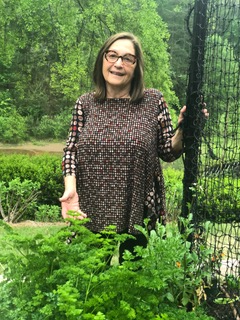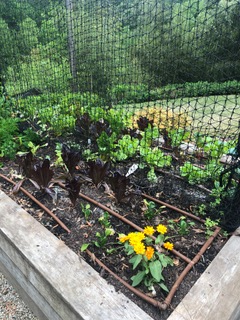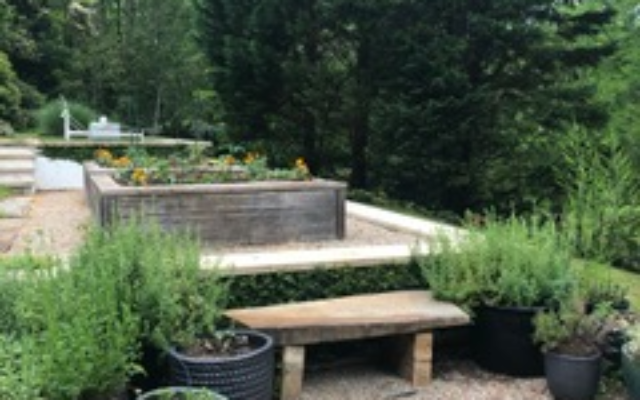Pollack Touts: ‘Grow It Yourself’
An experienced teacher shares gardening as art.
After 37 years with the Atlanta Journal-Constitution and now with the AJT, , Jaffe’s focus is lifestyle, art, dining, fashion, and community events with emphasis on Jewish movers and shakers.
Master gardener and Sandy Springs resident Robin Pollack promotes the concept that “Horticulture therapy reduces stress and improves the quality of life. Connect with nature, involve the kids, learn about pruning and harvesting, and grab your own Caesar salad from the back yard.”
Pollack can be seen on YouTube, Facebook and the Chastain Park Conservancy site teaching useful skills on how to plant a victory garden.
The phrase “victory garden” was coined by George Washington Carver, and was used to reduce the pressure on the public food supply. In 1943, there were 18 million victory gardens in the U.S. constituting 40 percent of the nation’s fruits and vegetables. Eleanor Roosevelt planted one on the White House lawn to boost morale during World War II. Victory gardens can be in public parks or private residences to bolster the food supply and reduce market pressure by contributing labor while supplementing home-grown rations. In 1917, the government advocated the planting of war gardens to free up food for soldiers.

Fast forward to this unprecedented pandemic. Americans once more feel empowered to leave more on the grocery shelves for others, while securing a home backyard fresh food supply. Pollack has undertaken an instructional series at the Chastain Park Conservancy, “How to Plant a Victory Garden,” with offshoots such as “How to Plant a Pizza Garden.” Pollack is a virtual “green thumb” fountain of knowledge with the ability to share that talent after decades as an art teacher.
“Gardening is art to me. Think of it as color, texture and shape.”
Pollack’s father was an attorney in the Air Force. “We lived in England where I was involved in our gardens – especially picking weeds! After we moved to Atlanta, Mom wouldn’t let me go to Lenox (open air) Mall unless I first worked in the garden. The outdoors is my playground.”
Trained by the University of Georgia master gardener program in urban agriculture and passing a rigorous exam, she now donates her time as part of the county extension services to teach others. She is an instructor at Farm Chastain with North Fulton Master Gardeners and Chastain Park Conservancy.

In Pollack’s own backyard, she uses a golf cart to transport tools and supplies. She has four raised beds: tomatoes, eggplant and peppers, lettuces, and herbs. She warns, “You have to watch that herbs don’t take over. Some, like mint, sage and chives, can be in separate pots. Okra has to be by itself as it grows tall. I also have pineapple sage, which the butterflies like, … lavender, flat leaf parsley, chives.
Plant what you like to eat.” She has a scuppernong vine which originated in 1950.
Here she shares some tips on planting a victory garden:
Start with a 4-by-4-foot space, line up vertical and horizontal strings 1-foot apart.
Plant east to west with the taller plants on the north side, smaller on the south.
Make sure you get six to eight hours a day of sun. Vegetables need 1 to 2 inches of water a week.
Put labels by the plants. Balance nutrient rich soil. Send it off to the county to test pH. Stick with standard tried and true varieties for your first experience.
Evaluate how big the mature plant will be, not what it looks like now. Squash and peppers need a foot all around, herbs can be tighter together. Asses if tomatoes will be on a stake, trellis or a cage.
Zinnias nearby are useful to detract bugs.
Forget toilet paper as the new “in” commodity. Growing one’s own food is a distraction and escape that results in fresh produce. Nurseries are seen as necessary businesses. Orders can be placed online and picked up on location or delivered.
According to “CBS Sunday Morning” last month, “In our upended lives, spring has come on time. Gardens put us in our happy place.” Nurseries are selling out while home gardeners are snapping up fruit and vegetable plants. “Victory Gardens represent safety and security with nutritious food.”
Pollack said, “If you start now, you can have produce in 30 to 45 days. Get the kids involved, practice social distancing, and enjoy your garden to the fullest!




comments